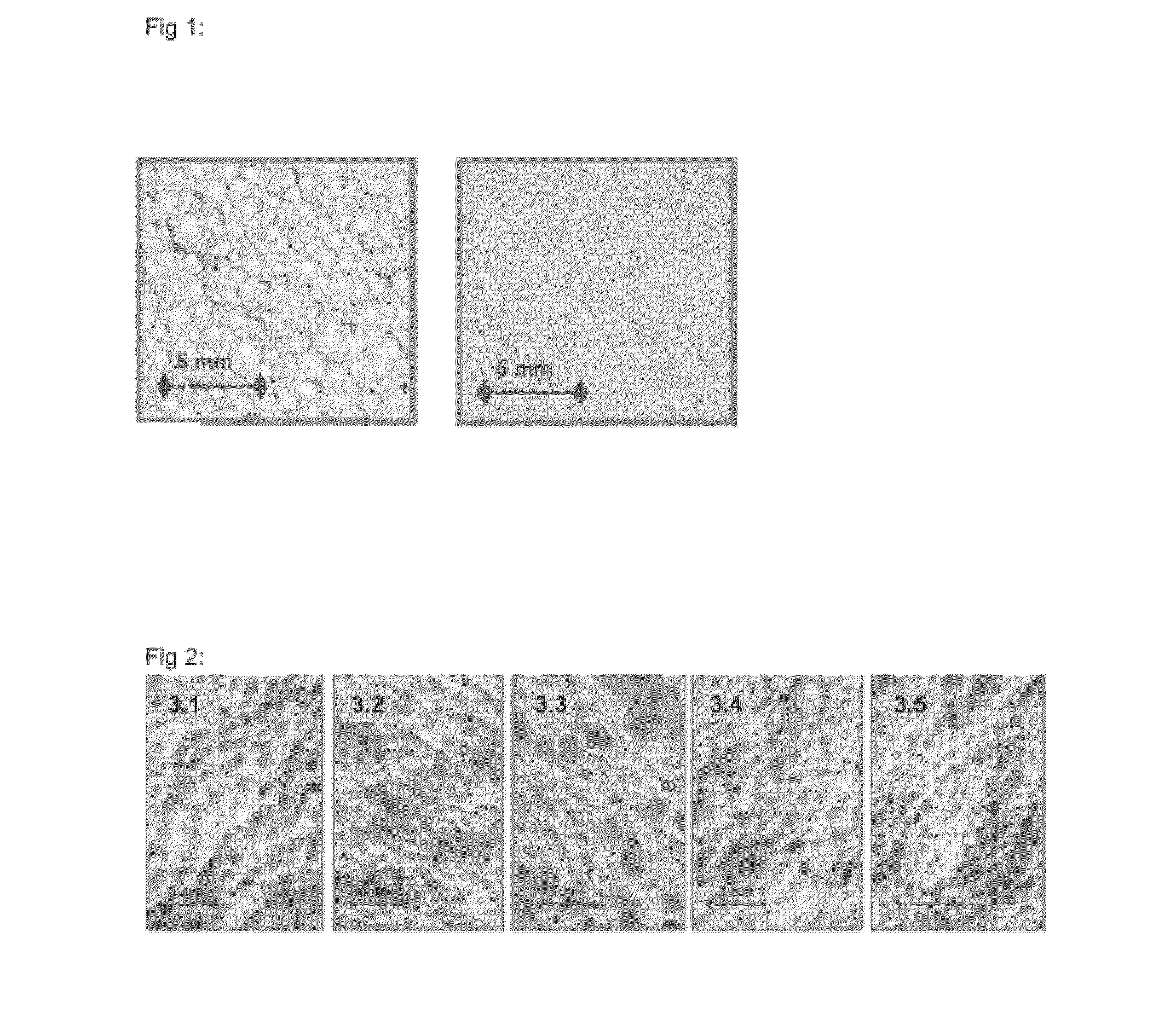Light-weight gypsum board with improved strength and method for making same
a technology of gypsum board and strength, which is applied in the field of light-weight gypsum board with improved strength and method for making same, can solve the problems of reducing calcium sulfate levels, reducing strength products, and reducing the ability to retain workability
- Summary
- Abstract
- Description
- Claims
- Application Information
AI Technical Summary
Benefits of technology
Problems solved by technology
Method used
Image
Examples
example 1
[0097]Foam based on fatty alkyl sulfate was produced in the following way:
[0098]A tenside solution, containing 0.3% of sodium decylsulfate, was filled in a supply tank and routed to a foam generator. By use of a stator rotor system, and by addition of compressed air, the tenside solution was transferred into foam. The adjusted foam density was 75 g / L.
[0099]Estimation of initial setting:
[0100]Initial setting was determined with the so-called knife-cut method (analogous to DIN EN 13279-2)
[0101]Estimation of flow:
[0102]Row was determined after a time of 60 seconds. After adding powder components to liquid the stucco had to soak for 15 seconds. Then the slurry was mixed for 30 seconds with a Hobart mixer. After a total time of 45 seconds a cylinder was filled with the stucco slurry up to the top edge and lifted after 60 seconds. At the end the patty diameter was measured with a caliper rule on two perpendicular axes.
example 2
Adjustment of Pore Structure with Dispersant No. 8 Subject to Invention and Different Foaming Aids
Mixture 2.1
[0109]A tenside solution, containing 0.3% of Vinapor® GYP 3110, a foaming agent for coalescencing foam (BASF) was filled in a supply tank and routed to a foam generator. By use of a stator rotor system, and by addition of compressed air, the tenside solution was transferred into foam. The adjusted foam density was 75 g / L.
[0110]3.390 g of dispersant No. 78 subject to invention (29.5% active; means 0.2% active related to stucco;), 500 g stucco (β-hemihydrate from natural source) and 0.46 g accelerator (fine milled dehydrate from ball mill to adjust a setting time of about 2:20 min:s) was interspersed in 337.37 g water. Then the powder had to soak in liquid for 15 seconds. Afterwards the slurry was mixed with the Hobart mixer at level II (285 rpm) for 30 seconds. Meanwhile 19.53 g of the alkyl sulfate-based foam, having a density of 75 g / L, was added to the slurry to adjust a gy...
example 3
Robustness of Pore Structure with Dispersant No. 8 Subject to Invention in Comparison to BNS
[0114]Analogues to example 1 and 2 five different mixtures were adjusted at a dry density of 665+ / −5 kg / m3, a flow of 18.5+ / −0.3 cm and an initial setting of 2:00 min:s to 2:20 min:s. After setting a foamed test specimen was broken to evaluate pore structure. The tenside solution (0.3% Vinapor® GYP 3110, was prepared with the stator rotor system and had an adjusted foam density of 75 g / L.
[0115]FIG. 2 shows that by use of 0.1% of BNS (3.2) the pores become little finer in comparison to reference mixture (3.1) without dispersant. Adding 0.3% of BNS to the slurry (3.3) leads to little coarser pores. Addition of 0.1% (3.4) or 0.3% (3.5) of dispersant No. 8 subject to invention ends in similar pores like reference system. This indicates high robustness to foaming aids.
PUM
| Property | Measurement | Unit |
|---|---|---|
| mole ratio | aaaaa | aaaaa |
| weight % solids | aaaaa | aaaaa |
| density | aaaaa | aaaaa |
Abstract
Description
Claims
Application Information
 Login to View More
Login to View More - R&D
- Intellectual Property
- Life Sciences
- Materials
- Tech Scout
- Unparalleled Data Quality
- Higher Quality Content
- 60% Fewer Hallucinations
Browse by: Latest US Patents, China's latest patents, Technical Efficacy Thesaurus, Application Domain, Technology Topic, Popular Technical Reports.
© 2025 PatSnap. All rights reserved.Legal|Privacy policy|Modern Slavery Act Transparency Statement|Sitemap|About US| Contact US: help@patsnap.com


